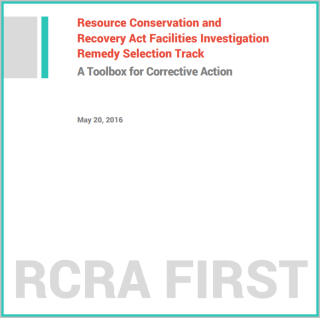A Toolbox for Corrective Action: Resource Conservation and Recovery Act Facilities Investigation Remedy Selection Track
The Resource Conservation and Recovery Act Facilities Investigation Remedy Selection Track Toolbox for Corrective Action distills practical lessons learned and experiences contributed by federal, state, and regulated community representatives involved with investigation and remedy selection worldwide.
On this page:
The RCRA FIRST Approach

EPA designed the RCRA FIRST approach to improve the efficiency of RCRA facility investigations and remedy selection at Hazardous Waste Cleanup Program (RCRA Corrective Action) Facilities. The RCRA FIRST approach:
- Addresses the root causes of delay, such as:
- Unclear or non-specific investigation or cleanup objectives.
- Lack of specific opportunity and process to elevate differences among interested parties early in the process.
- Starts with multi-party understanding of the objectives in investigation and remedy selection phases.
- Enhances communication among project participants.
- Promotes the principle of “done right the first time” and avoids re-do loops.
- Advances critical decision-making through rapid elevation to resolve disputes.
- Stays within the technical and regulatory framework of the corrective action program.
The RCRA FIRST Toolbox

The RCRA FIRST toolbox and associated tools will help EPA Regional staff and their partners to take advantage of the efficiency and quality gains from the RCRA FIRST approach. The toolbox includes a how-to guide, process flow maps, and tools and templates to make it easier to complete different parts of the FIRST approach and monitor its effectiveness. Project teams can customize the resources to meet each region or state’s specific needs. The tools are also downloadable in individual files.
- Memo from Barnes Johnson, Office Director, Office of Resource Conservation and Recovery, Regarding RCRA FIRST (pdf)
- A Toolbox For Corrective Action: Resource Conservation and Recovery Act Facilities Investigation Remedy Selection Track (RCRA FIRST) (pdf)
- Tool 1: Model Corrective Action Framework (CAF) Meeting Agenda (pdf)
- Tool 2: Corrective Action Framework Template (pdf)
- Tool 3: Elevation Process (pdf)
- Tool 4: RCRA Facility Investigation Data Sufficiency Evaluation (pdf)
- Tool 5: Conceptual Site Model Iterative Evaluation Update Tool (pdf)
- Tool 6: Template Agenda for Remedy Selection Process Meeting (pdf)
- Tool 7: Developing Corrective Action Objectives (pdf)
- Tool 8: Post-Remedial Care Considerations (pdf)
- Tool 9: Remedy Selection Process Document (pdf)
- Tool 10: Control Plan (pdf)
- Tool 11: Communication Plan (pdf)
- Tool 12: Project Manager Transition Checklist (pdf)
- Example CAF Meeting Agenda for Restarting a Stalled RFI (pdf)
- Example CAF for a New RFI (pdf)
- Example Corrective Action Agenda for Remedy Selection (pdf)
